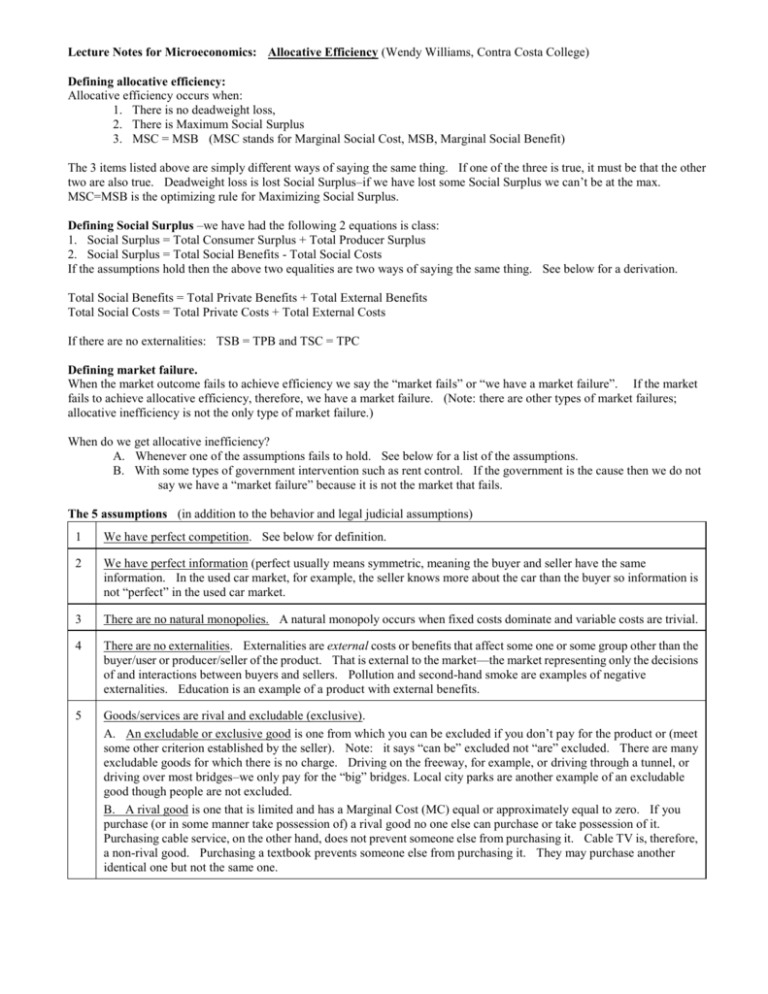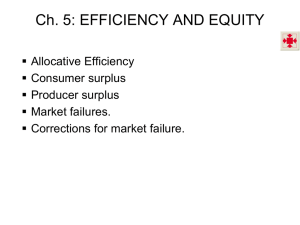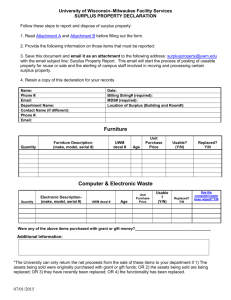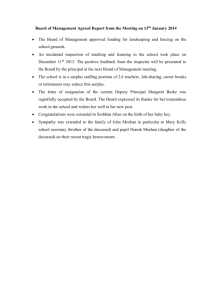Lecture Notes for Microeconomics: Allocative Efficiency (Wendy
advertisement

Lecture Notes for Microeconomics: Allocative Efficiency (Wendy Williams, Contra Costa College) Defining allocative efficiency: Allocative efficiency occurs when: 1. There is no deadweight loss, 2. There is Maximum Social Surplus 3. MSC = MSB (MSC stands for Marginal Social Cost, MSB, Marginal Social Benefit) The 3 items listed above are simply different ways of saying the same thing. If one of the three is true, it must be that the other two are also true. Deadweight loss is lost Social Surplus–if we have lost some Social Surplus we can’t be at the max. MSC=MSB is the optimizing rule for Maximizing Social Surplus. Defining Social Surplus –we have had the following 2 equations is class: 1. Social Surplus = Total Consumer Surplus + Total Producer Surplus 2. Social Surplus = Total Social Benefits - Total Social Costs If the assumptions hold then the above two equalities are two ways of saying the same thing. See below for a derivation. Total Social Benefits = Total Private Benefits + Total External Benefits Total Social Costs = Total Private Costs + Total External Costs If there are no externalities: TSB = TPB and TSC = TPC Defining market failure. When the market outcome fails to achieve efficiency we say the ―market fails‖ or ―we have a market failure‖. If the market fails to achieve allocative efficiency, therefore, we have a market failure. (Note: there are other types of market failures; allocative inefficiency is not the only type of market failure.) When do we get allocative inefficiency? A. Whenever one of the assumptions fails to hold. See below for a list of the assumptions. B. With some types of government intervention such as rent control. If the government is the cause then we do not say we have a ―market failure‖ because it is not the market that fails. The 5 assumptions (in addition to the behavior and legal judicial assumptions) 1 We have perfect competition. See below for definition. 2 We have perfect information (perfect usually means symmetric, meaning the buyer and seller have the same information. In the used car market, for example, the seller knows more about the car than the buyer so information is not ―perfect‖ in the used car market. 3 There are no natural monopolies. A natural monopoly occurs when fixed costs dominate and variable costs are trivial. 4 There are no externalities. Externalities are external costs or benefits that affect some one or some group other than the buyer/user or producer/seller of the product. That is external to the market—the market representing only the decisions of and interactions between buyers and sellers. Pollution and second-hand smoke are examples of negative externalities. Education is an example of a product with external benefits. 5 Goods/services are rival and excludable (exclusive). A. An excludable or exclusive good is one from which you can be excluded if you don’t pay for the product or (meet some other criterion established by the seller). Note: it says ―can be‖ excluded not ―are‖ excluded. There are many excludable goods for which there is no charge. Driving on the freeway, for example, or driving through a tunnel, or driving over most bridges–we only pay for the ―big‖ bridges. Local city parks are another example of an excludable good though people are not excluded. B. A rival good is one that is limited and has a Marginal Cost (MC) equal or approximately equal to zero. If you purchase (or in some manner take possession of) a rival good no one else can purchase or take possession of it. Purchasing cable service, on the other hand, does not prevent someone else from purchasing it. Cable TV is, therefore, a non-rival good. Purchasing a textbook prevents someone else from purchasing it. They may purchase another identical one but not the same one. Note the distinction between government determined or influenced outcomes and a pure market outcome. Even though the US economy is characterized as a ―free-market‖ economy, very few markets are completely free of government intervention. How many markets can you identify for which there are no government influences? Defining Perfect Competition. Perfect competition is one of the four basic types of market structure as defined in the following table. Perfect Competition Monopolistic Competition Oligopoly (includes duopoly) Monopoly Many sellers Many sellers Few sellers Homogenous Product Differentiated Product Differentiated Product Unique Product No barriers to entry No barriers to entry Barriers to entry Substantial barriers Price taker (P=MR) Price setter (P>MR) Price setter (P>MR) Price setter (P>MR) Economic Profits = 0 in the Long Run Economic Profits = 0 in the Long Run Economic Profits > 0 in the Long Run Economic Profits > 0 in the Long Run One seller Look for the patterns: Markets in which there are no barriers to entry will have many firms and no economic profits in the long run. Markets with barriers to entry an maintain economic profits even in the long run. Markets that have differentiated or unique products are price setters. Firms will try to limit their competition by, among other methods, creating barriers to entry. Firms will also try to differentiate their product from their competitor’s. In the real world, there are not too many markets which are perfectly competitive nor are there many monopolies. Proof. If all the assumptions hold, the market outcome is allocatively efficient. we know that: because: MC = MR firms are rational optimizers and they follow the profit max rule MR = P firms are perfectly competitive and are, therefore, price takers P = MU households follow the simple rule of Consumer Surplus maximization If MC=MR and MR=P and P=MU, then MC=MU. If there are no externalities then MU=MSB and MC=MSC and it follows that MSB=MSC. Since MSB=MSC is the optimizing rule for maximizing Social Surplus we have allocative efficiency. This is using the simple optimizing rule for households in maximizing their Consumer Surplus. The same case can be made with the more realistic optimizing rule (equalizing the bang for the buck). ____________________________________________________________________________________ Derivation: From Social Surplus equation #1 (SS = CS + PS) to Social Surplus equation #2 (SS = TSB - TSC) SS = CS + PS and CS = TU-PQ, SS = (TU-PQ) + (PQ-TC) SS = TU - TC And if assumptions hold: TU = TSB and TC = TSC SS = TSB -TSC PS=PQ-TC






